What to do if the chimney flue freezes: effective ways to protect the chimney
There are frequent cases when a gas boiler or column can stop working due to freezing of the gas pipe. But no one wants to stay on a winter evening without hot water or even without heating, right?
Therefore, we will talk about why the chimney of a gas column or boiler freezes, what measures should be taken to deal with this problem, and what can be done to avoid a similar situation in the future. Supplemented material supplemented by thematic photos and videos.
The content of the article:
The main causes of chimney freezing
Among the causes of chimney freezing, first of all, adverse weather conditions: wind, low air temperature, high humidity. All this leads to freezing of the gas boiler pipe. Among the reasons can be called falling into the snow pipe, and errors made during the installation phase. In this case, the result is one: the mini-boiler room ceases to function.
The most important rule that must be strictly observed: strictly follow the manufacturer's recommendations, take into account the length and angle of the pipe, its location.
One more reason - condensation. Condensate - the presence of water vapor in the combustion products. Moreover, its temperature is lower than the dew point. When freezing water droplets, an ice crust forms. It prevents the access of air that supports the combustion process. If the boiler is located on the upper floors of the house, it is impossible to get to the terminal to get rid of the ice crust.

The main signs that the chimney of a gas boiler in a private house freezes are the following:
- the appearance on the boiler display of the error "flame separation";
- condensation on the surface of the duct;
- after switching on the boiler, it goes out after a short time.
There are such ways to reduce the amount of condensate: insulation chimney channel thorough maintenance of the system (timely cleaning); application steam trap.
The latter is a container made of stainless steel. Its purpose is to collect the moisture that has appeared.
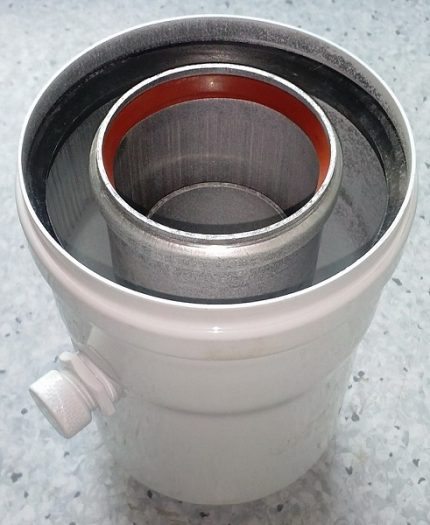
If we talk about preventive measures, the following can be noted:
- at the stage of building a house, comply with all standards;
- to install the chimney in strict accordance with the project;
- do not forget about cleaning the smoke channel using special tools;
- improve existing pipes (insulation measures, the use of stainless steel liners);
- monitoring the power of equipment and, if necessary, cleaning the chimney.
Such an approach is entirely justified, since preventing a problem is always easier than eliminating it. We recommend that you familiarize yourself with prevention methods condensation
Ways to get rid of icing
The purpose of the chimney is the removal of the compounds formed during the combustion of fuel. The fuel consumption, that is, the efficiency of the boiler, largely depends on its design.
Cost-effectiveness of the system depends on such factors:
- workmanship chimney;
- height, diameter and location of the pipe.
Reduced efficiency, excessive gas consumption, wet walls, carbon monoxide penetration into the room, chimney freezing - all these problems can arise due to the chimney being selected and installed incorrectly.
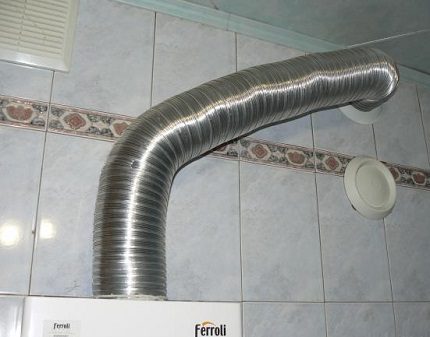
Now let's talk about what measures can be taken to prevent the formation of ice. Partial Solution - stub removal at the top of the boiler. The combustion products, as before, will go outside. The air that is needed for the combustion process will be directed into the system from the room. Therefore, for security reasons, it is so important to arrange the right ventilation for gas boiler.
However, the plug must be returned to its original place when the ice growth melts. It is impossible to maintain this mode constantly. The fact is that the impurities contained in the air of the room (dust, soot from the kitchen) will quickly disable the heating unit. You can use this method if icing is a rarity, no more than twice a year. With regular freezing use the kit "anti-ice».
In addition to taking air from the room, there are other ways to eliminate icing.
Method # 1 - reduce the temperature difference
If the boiler equipment does not include regulators and (or) programmers, then it is switched on according to the difference between the temperatures of the heating circuit lines: supply and return. If the model of equipment is programmable, then the indicator can be adjusted.
So that the coaxial chimney does not freeze in winter, set the temperature difference to a minimum. Thus, the time interval between turning the unit off and on is shortened. It is advisable to perform the work at an air temperature below -10 degrees.
Method # 2 - increase boiler power
An increase in boiler power leads to an increase in the temperature of gases that warm the pipe more. Of course, fuel consumption will increase, but there will definitely not be a problem with icing.
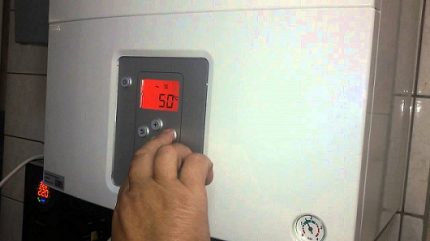
Regulation of gas equipment capacity without professional skills is a risky and dangerous activity. If changing the gas flow rate on the valve is an unfamiliar process for you, then it is advisable to use the services of a representative of the organization with which you contract signed for service. The specialist will do the job efficiently and quickly.
Method # 3 - improvement of the coaxial pipe
For the column and boiler, coaxial pipes are installed with an inclination to the street. This is necessary so that the condensate formed in the air channel drains out.
Sometimes the reason for the accumulation of water is that the extreme part of the duct was severely deformed. Good results can be achieved by cutting the outer part of the pipe by 150-200 mm or by making holes in it. The inner pipe along the length remains unchanged.
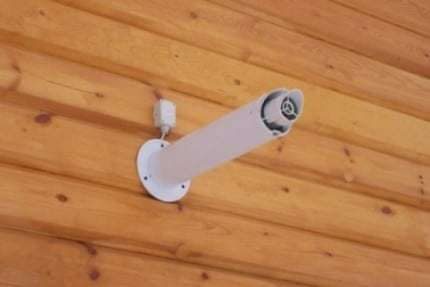
Method # 4 - chimney insulation
The chimney is insulated in order to prevent condensation due to the difference between the internal and external temperatures. In addition, thermal insulation serves to protect the roof in the immediate vicinity of the boiler chimney or column.
For insulation, the following methods are used: plastering slag solution, brick, mineral wool, slag concrete slabs.
The benefits of thermal insulation include:
- a significant reduction in the deposition of chemically aggressive combustion products on the inner walls of the pipe. A stream of smoke and hot air takes them out almost completely;
- reducing the temperature difference between the walls of the pipe and the hot air that comes out of the furnace;
- minimizationheat loss, heightenergy efficiency systems - heat losses in the presence of an insulator are significantly reduced;
- additional stability of the chimney - thanks to the insulating casing, it becomes more resistant to weather and wind, the pipe is less destroyed by external factors.
If the insulation is selected correctly and all the work is done correctly, you should not be afraid of freezing, even in forty-degree frost. In addition, sections of the roof in the immediate vicinity of the chimney suffer much less from high temperatures. Next, we consider the main methods of insulation.
Plastering
Application areaplastering on the grid - external insulation of brick pipes. If the work is done correctly, levelheat loss decreases by about a quarter.
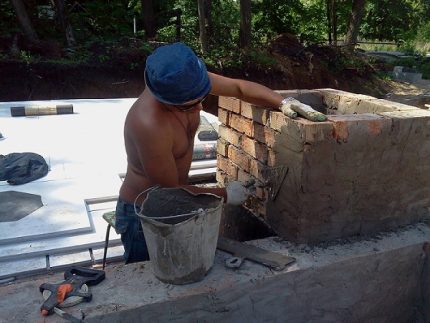
To do this, prepare a mixture based on slag, cement and lime. The solution is applied to a reinforced mesh with a layer of 30 mm. After the mixture has dried, mineral wool is placed on top of it. This is followed by a layer of plaster andfiberglass mesh.
When the entire multilayer structure dries, the pipe is covered with a primer layer and painted - you can use any dye for outdoor work. As an external cladding, you can use a metal siding.
To the benefitsplastering pipes include: low cost of work, aesthetics of the final result, the availability of implementation for almost everyone.
Use of mineral wool
The scope of mineral wool is insulation of pipes made of asbestos or metal. Compared to the usual stucco, the use of mineral wool has a number of advantages: low weight, minimal labor intensity, resistance of the material to high temperatures, incombustibility and low cost.
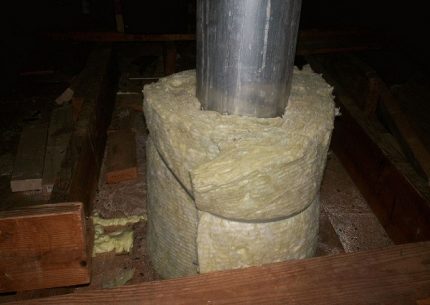
Insulation proceduremineral wool following:
- cleaning the outer surface of the pipe;
- lathing production from profiles - guides are fixed with dowels;
- fastening of vertical racks, connecting them with guides - the interval between the racks corresponds to the thickness heat insulator;
- laying mineral wool in the crate - a layer of polyethylene is placed on top of the insulating layer, the joints are sealed with aluminum tape.
The final step is to install the cladding fromcorrugated board.
Brick casing construction
The construction of a casing made of bricks is one of the most common methods of thermal insulation of metal chimneys.
This design has many advantages: a beautiful view, durability, moisture resistance, the ability to use improvised materials. There are also disadvantages: the high complexity of the work, the need for certain building skills. In addition, additional costs forthermal insulation not to be avoided.
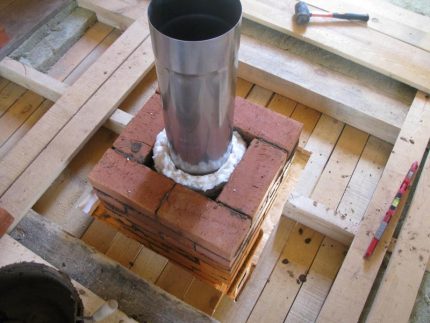
To make the construction reliable and durable, you need a small foundation.
- Dig a hole below the level of freezing. Otherwise, after the very first frosts, the structure is deformed and destroyed. The length of the pit and its width should exceed the design parameters of the same name by 100-150 mm.
- Press the bottom of the pit, align the walls. A 100 mm sand cushion is poured into the bottom and tamped.
- Inside the formwork is mounted, it can be fixed. To do this, buy a finished design or make it yourself from polystyrene foam. Formwork at the same time serves as additional waterproofing.
- Using a 10mmfiberglass or metal fittings, a crate is made with crossbars through 400 mm and 50 mm smaller than the pit.
- The bottom is laid out with a brick, on which the prepared crate is placed. The resulting structure is poured with concrete and rammed with a vibrator. The foundation is left for 3 weeks to solidify.
After the base is fully ready for operation, proceed to the installation of the casing. Its dimensions are such that the internal distance to the pipe is about 50 mm. For masonry, use a ready-made building mixture or mix cement, fireclay sand and crushed brick in a ratio of 1: 3: 1. Dry components are mixed first and only then water is added.
Before starting work, the foundation is protected from water by a layerbicrosta or roofing material. Brickwork is performed in a circle with a binding. Every 3-5 rows lay out a metal mesh. The plane is constantly monitored by level. As the casing is laid out, the void between the pipe and the masonry is filled with insulation.
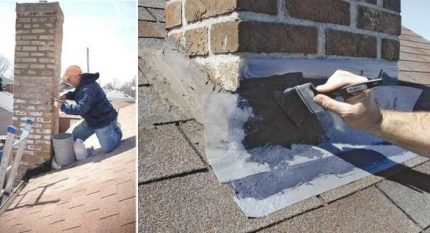
Using extruded polystyrene foam
Scope of plates fromextruded polystyrene foam - external insulation of chimneys made of brick. The propertiesfoam andtechnoplex - high level of strength and impermeability to water.
It is advisable to use asheat insulator heat resistant grades with flammability class G2. Class Products G3 and G4 It has less fire resistance, therefore, at a high (more than 600 degrees) temperature of the exhaust gases it is not used.
For the production of insulation penoplex will be required:
- insulation (the required amount is calculated individually);
- suspensions;
- metal profile;
- fastenings;
- construction foam;
- from tools - a drill or a perforator.
The plates are fixed to the pipe surface using non-combustible glue (it is also used to seal joints).You can use construction foam.
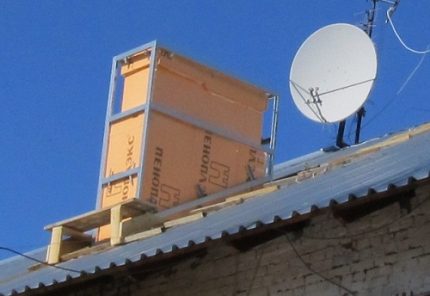
The algorithm is as follows:
- Suspensions are fixed at the corners of the chimney from all sides. The vertical distance between them is chosen so that it can be fixedheat insulator. The pendants are given a U-shape.
- Sheetfoam apply and slightly press down so that there are traces of fastenings.
- The insulation is deployed and in the places of tracks make through cuts.
- The back of the insulator is covered with foam.
- Metal plates are threaded through the insulation, sheets are pressed tightly against the pipe.
- A profile is mounted to the suspensions. It must be smoothed out, because it is he who serves as the basis for the cladding.
- Sheets fastenscrews with press washers or rubber seals. Corners are closed with special strips. This is necessary to create the effect of solidity. The gap between the insulator and the profile is closed by a tin plate that prevents the penetration of water.
- A visor is mounted in the upper part.
To form the thermal insulation of the asbestos pipe, install a galvanized casing at a distance from the pipe not less than 60-80 mm. Glass insulation is used as insulation. Cement mortar is used to fill the remaining gaps.
You can do without a casing, then asheat insulator it is better to choose mineral wool - its consumption will turn out twice as much.
Arrangement of a chimney from a sandwichpipe
This is an excellent solution to solve the problem of chimney insulation by almost a hundred percent. The disadvantage of sandwich pipes is one: the channels will need to be completely redone or, as an option, provide for their installation at the design stage of the house.
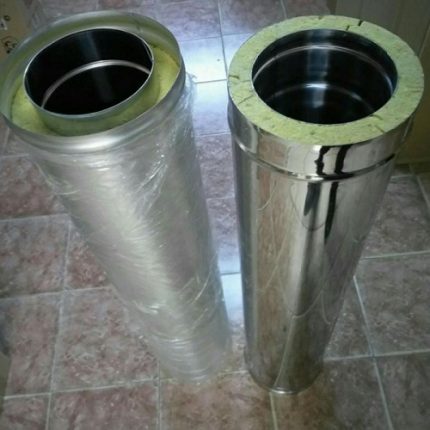
A sandwich is 2 pipes with different diameters, the smaller of which is inside the larger. They are separated by a layer of insulation material. Condensation does not form on the sleeves, and overheating does not occur, so the system is completely fireproof.
Installation of such a chimney does not cause special difficulties, sandwich system going by the principle of a constructor. Panels are inserted into each other to the required size. Connection to the boiler is carried out by means of special additional adapters.
Common insulation errors
The main indicator that a mistake was made when arranging thermal insulation was heating the external parts of the structure to high temperatures. If flammable materials are nearby, this could result in a fire hazard.
The reasons for this are as follows:
- improperly selected or poor-quality insulator shrinks;
- violation of the integrity of the inner part of the pipe (it happens quite rarely);
- non-compliance with work technology;
- uncovered heat insulator in the tip of the chimney.
Thus, thermal insulation methodschimney quite a lot of pipes. Materials are available for sale, so there will be no problems with the purchase.
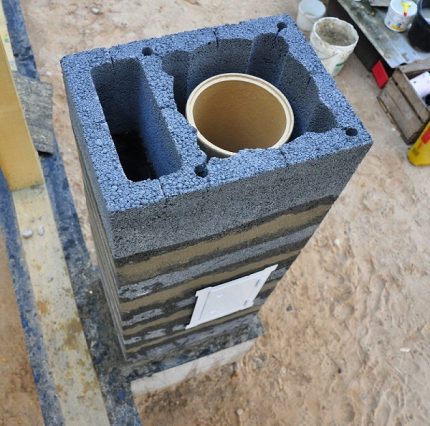
How to protect the column from freezing?
Your gas column freezes through the chimney pipe and you don’t know what to do to avoid this problem? Let's take a closer look at this issue.
In the equipment manual is prescribed temperature conditionat which the equipment is functioning normally. If the outside temperature drops, individual components of the water heater may fail.If the device is under warranty, this does not mean that there is absolutely nothing to worry about. The manufacturer company clearly prescribes operating standards, violation of which threatens with a loss of warranty.
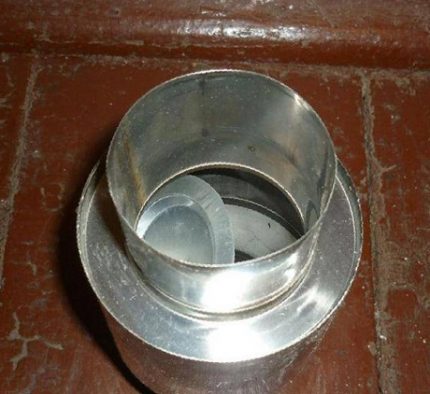
Freezing can be avoided if drain water in a timely manner. This applies not only to country cottages, but also devices that are in private houses or apartments.
It is necessary to drain the water in the following cases:
- abnormally frosty weather;
- frequent power outages;
- unheated room.
Such a measure will not hurt if you leave for a week or more, which means that the gas column will not be operated.
To drain the water, shut off the gas valve and the inlet water tap. Then open the hot water on the mixer and wait until the water has completely merged.
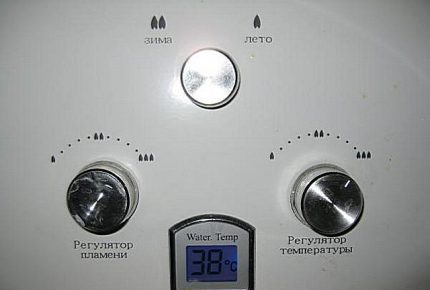
Another case is possible when the column is in a warm room and still freezes. The part of the pipe that is in the room remains warm. And that part of it, into which the "street" air gets, goes into minus. Condensate forming in the pipe turns into ice, which, in turn, fetters the check valve. The exhaust gas from the column will thus be blocked - the fan will not be able to open the valve. It will be impossible to include a column in such a situation.
The solution to the problem is quite simple. You can use an ordinary household or construction hairdryer. The device must be turned on in maximum heating mode. Now it remains to heat the pipe. The ice will melt quickly and the valve will be released. Now you can turn on the column and let it work for 10 minutes to smoke exhaust the line has completely warmed up and dried out.
Sometimes the cause of freezing is problems with ventilation or manufacturing flaws. If the device is under warranty, contact a service center. If the warranty time has passed, sealing the case helps.
Conclusions and useful video on the topic
Kit for protecting coaxial pipes against ice overgrowth in the following video:
Chimney insulation - 1 part, video
Chimney insulation - 2 part, video
Fixing a failed column is quite an expensive pleasure. Simple manipulations and precautions outlined in the article will help you save equipment from damage, and protect yourself from unjustified expenses. A column will delight you with stable operation and hot water for a long time.
You also encountered the problem of freezing the chimney and want to talk about your method of solving this problem? Write about your experience, participate in the discussion, ask questions to our experts and other visitors to the site - the feedback form is located below.

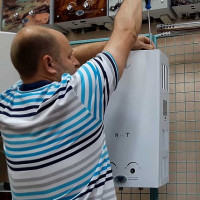 What to do if the geyser flows: an overview of the main causes and recommendations for their elimination
What to do if the geyser flows: an overview of the main causes and recommendations for their elimination 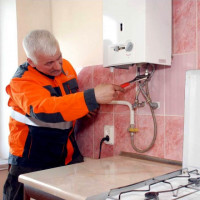 Do-it-yourself gas column installation in an apartment: requirements and technical standards for installation
Do-it-yourself gas column installation in an apartment: requirements and technical standards for installation  Replacement of a geyser in an apartment: replacement paperwork + basic norms and requirements
Replacement of a geyser in an apartment: replacement paperwork + basic norms and requirements 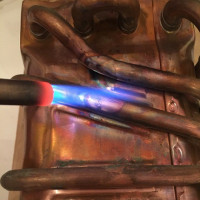 Do-it-yourself repair of a gas column heat exchanger: the main stages of soldering a copper radiator
Do-it-yourself repair of a gas column heat exchanger: the main stages of soldering a copper radiator 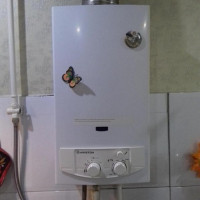 The principle of operation of a gas column: features of the device and operation of a gas water heater
The principle of operation of a gas column: features of the device and operation of a gas water heater 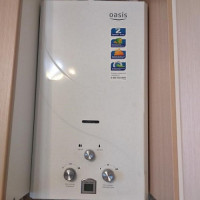 Oasis gas column repair: an overview of typical breakdowns and recommendations for their elimination
Oasis gas column repair: an overview of typical breakdowns and recommendations for their elimination  How much does it cost to connect gas to a private house: the price of organizing gas supply
How much does it cost to connect gas to a private house: the price of organizing gas supply  The best washing machines with dryer: model rating and customer tips
The best washing machines with dryer: model rating and customer tips  What is the color temperature of light and the nuances of choosing the temperature of the lamps to suit your needs
What is the color temperature of light and the nuances of choosing the temperature of the lamps to suit your needs